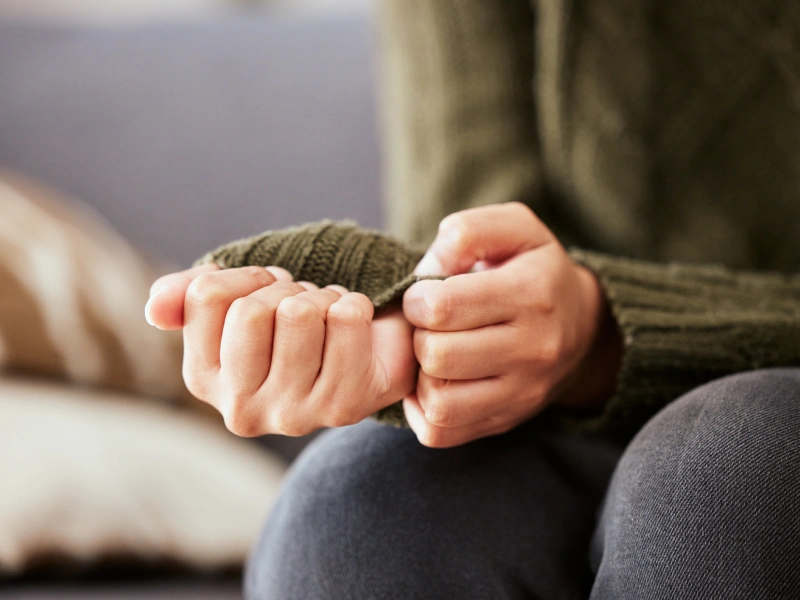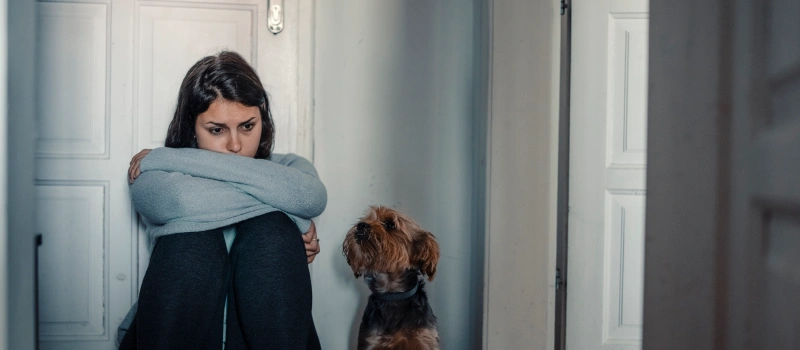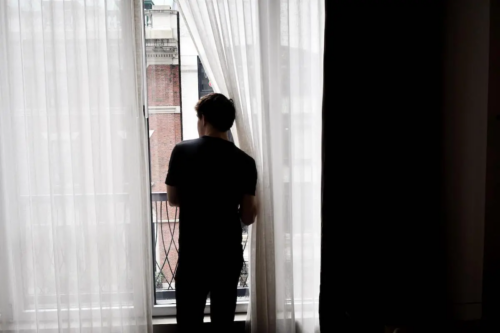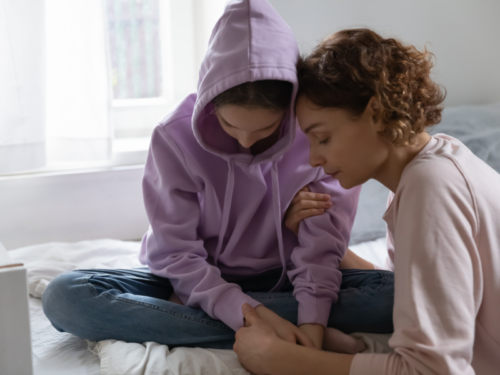
Table of Contents
Is it Normal to be Afraid of People?
Written By: Charlie Health Editorial Team

Clinically Reviewed By: Dr. Don Gasparini
January 24, 2023
8 min.
It's normal to experience social anxiety in certain situations, but did you know there is a clinically-recognized phobia of people?
Learn more about our Clinical Review Process
Table of Contents
If you are dealing with an ongoing fear of people, you may have anthrophobia. This phobia can impact your mental health and make it difficult to interact with others. Learn more about the clinical fear of people, including its symptoms, causes, treatment options, and how it can affect teens and young adults.
What is the phobia of people?
Anthrophobia, or the fear of people, is a mental health condition that can cause extreme discomfort and even panic attacks. Its symptoms include an irrational feeling of dread and sometimes increased heart rate when exposed to social settings, avoidance of crowded places or simply people in general, and feelings of wanting to be alone in one’s own space.
People with anthrophobia often become anxious just by the thought of facing other people and might find it difficult to participate in conversations or engage in job-related activities due to their fear. Anthrophobia can impact any individual regardless of age or background, including teenagers and young adults who may need to seek mental health support in order to better cope.
When considering phobias, anthrophobia may not be the first type that comes to mind. There are many other phobias that are more widely discussed (and frankly, accepted) than anthrophobia, but an extreme fear of people is no less detrimental to both physical and mental health than other types of phobias. Those struggling with a serious fear of people may experience symptoms such as extreme anxiety and dread when around people, irrational thoughts, or sudden panic attacks in situations where there is a lot of socializing.
In rare cases, the fear can be so debilitating that the individual avoids any kind of human contact; this avoidance can contribute to depression and can further degrade mental health. Even mild levels of this phobia can pose challenges, such as difficulty being part of a team or communicating effectively with bosses and colleagues. A proper understanding and awareness of this phobia is crucial in helping those who suffer from its effects receive adequate support, understanding, and treatment.
Defining anthrophobia and its symptoms
Anthrophobia is an intense fear that can cause physical and psychological symptoms such as:
- Rapid heart rate
- Difficulty breathing
- Dizziness, tremors
- Panic attacks
- Extreme social anxiety
- Avoiding public transportation
- Feeling overwhelmed when around people they do not know well
- Bouts of depression if separation from others becomes unbearable
Join the Charlie Health Library
Get mental health updates, research, insights, and resources directly to your inbox.
You can unsubscribe anytime.
It can be particularly challenging for those suffering from anthrophobia to be in wide open spaces or large crowds. At its worst, the fear of people can make it difficult for individuals to manage regular activities such as going to school or work, which can put them at risk of further mental health struggles such as social anxiety disorder, agoraphobia, separation anxiety, obsessive compulsive disorder, panic disorder, and other types of clinically-diagnosable anxiety.
People struggling with a social phobia of people may also demonstrate avoidance behaviors like attempting to hide or leaving a situation quickly. Teenagers and young adults are especially vulnerable to developing this phobic disorder due to the close proximity between their peers and the high pressure associated with social situations.
Why do people develop a phobia of people?
The exact causes of anthrophobia remain largely unknown, but there is a widespread consensus that genetics, environment, and psychological factors can all contribute. Research has suggested that certain gene variants may increase our sensitivity to fear, making us more prone to developing phobias such as anthrophobia.
Psychological factors like perfectionism or a lack of control over one's life can also play a role in the development of this condition. There is still much to be studied with regard to the exact causes of anthrophobia, but it is highly probable that multiple complex factors are involved in its onset and progression.
Additionally, trauma can play a significant role in the development of anthrophobia. Traumatic events such as abuse, neglect, bullying, or other forms of mistreatment can lead to fearful behavior, intense anxiety, and mistrust towards others.
Trauma can also change the way the brain processes information and emotions, making it more likely for an individual to experience anxiety or panic in social situations. For example, a traumatic event can cause the brain to associate social situations with the traumatic event, leading to feelings of fear and anxiety when in similar situations.
Additionally, traumatic events can lead to the development of negative thoughts and beliefs about oneself and others, which can contribute to the development of anthrophobia. For example, an individual who has experienced abuse may believe that they are not worthy of love or that they cannot trust others. These negative thoughts and beliefs can lead to feelings of anxiety and fear in social situations.
It's important to note that not everyone who has experienced trauma will develop anthrophobia, and not everyone who has anthrophobia has a history of trauma. However, research suggests that a history of trauma is a risk factor for the development of a pervasive fear of people.
It's important to seek professional help if you suspect that you may have anthrophobia and that it is related to a traumatic event. A mental health professional can help you to process the trauma, address negative thoughts and beliefs, and work on coping mechanisms to reduce the symptoms of anthrophobia.

History of anthrophobia
The history of anthrophobia, or the fear of people, is not well-documented. The term itself is relatively recent, and it is likely that the fear of people has been present in human societies throughout history. However, the study and understanding of phobias, including anthrophobia, as a mental health disorder has only developed in the last century.
In the late 19th and early 20th centuries, phobias were considered to be a form of neurosis, a broad term used to describe a range of symptoms that were not fully understood. It was not until the development of modern psychiatric classification systems in the 20th century that specific phobias such as anthrophobia were recognized as distinct disorders.
The understanding of anthrophobia and its causes have evolved over time, but the condition has been recognized by the medical community for decades. Today, anthrophobia is classified as a specific phobia, a type of anxiety disorder characterized by excessive or irrational fear of a specific object or situation.
Anthrophobia is falls into the category of “specific phobias” in the DSM-5. A specific phobia is defined as a persistent and excessive fear of a specific object or situation, which causes clinically significant distress or impairment in social, occupational, or other areas of functioning. This phobia can be diagnosed if the individual has a marked and persistent fear of one or more situations or objects, and if the fear is out of proportion to the actual danger posed by the situation or object.
According to the National Institute of Mental Health, nearly 10% of teens experience a specific phobia.
Treatment options for anthrophobia
The treatment of the fear of people is important in helping individuals overcome their fear and live a healthier life. Common therapeutic guidelines for treating phobias include:
Cognitive behavioral therapy (CBT)
CBT can help an individual learn to identify and challenge irrational fears through talk therapy, relaxation techniques, and developing effective coping strategies with the help of a mental health professional.
Dialectical behavioral therapy (DBT) skills
DBT skills focus on teaching individuals skills to manage their emotions, thoughts, and behaviors in healthy ways. This can include learning how to regulate emotions, improve communication and relationships with others, all of which can help improve the symptoms of the phobia of people.
Mindfulness
Mindfulness can help an individual gain control over their anxiety symptoms by focusing on the present moment rather than the fear itself.
Exposure therapy
Exposure therapy is a type of behavioral therapy that involves gradually exposing a person to the thing they fear in a controlled and safe environment. This process helps the person learn that the feared object or situation is not actually dangerous and can help to reduce their fear and anxiety
Motivational interviewing
Motivational interviewing may be used to build on an individual’s strengths without placing any blame on them for the problem. With a combination of these therapies, individuals may find relief from their anxiety symptoms associated with the fear of people and potentially increase their quality of life. Anthrophobia is a treatable condition, and with the right treatment and self-help strategies, individuals can overcome their fear of people and improve their overall quality of life.
Do you need more support with
your mental health?
Charlie Health can help.
Teen coping skills for the phobia of people
The phobia of people, or anthrophobia, can have a significant effect on youth and teen mental health in a variety of ways. For instance, fear of interacting with other people can lead to unhealthy behaviors such as:
- Isolation
- Cyberbullying
- Depression
As young people are making their way through physical and social growth stages, it is important to recognize the signs of this particular fear in order to give them the help they need. Additionally, if left unaddressed, anthrophobia can make it difficult for teens and youth to maintain relationships due to feelings of paranoia or nervousness when interacting with others. It is therefore essential that adults take steps to ease this fear by providing education and support, which helps young people feel safe while forging healthier connections with each other.
In addition to therapy, there are also several self-help strategies that can be effective in managing the fear of people. These include:
Mindfulness and relaxation techniques
These can help to reduce anxiety and improve overall well-being.
Social support
Talking to friends and family about your fears can help to reduce anxiety and provide a sense of support.
Gradual exposure
Gradually exposing yourself to social situations in a controlled and safe environment can help to desensitize you to the fear.
Positive self-talk
Challenging negative thoughts and beliefs about being around people can help to reduce fear and anxiety.
Journaling
Writing down your thoughts and feelings can help you to identify patterns and triggers that contribute to your fear.
Trauma-informed therapy for phobias at Charlie Health
Phobias can profoundly affect mental health and wellbeing, often leading to pervasive depression, anxiety, and other psychological concerns in people of all ages.
A debilitating fear of people carries a particularly mounting toll on the mental health of youth and teens - those first starting out in life who are increasingly vulnerable. They may avoid social situations at all costs, even if it means missing out on important opportunities or experiences. They may also become excessively dependent on others, which can lead to problems in their relationships and interactions with others.
If you or someone you know is experiencing symptoms of anthrophobia, it's important to seek professional help. There are effective treatment options available that can help people manage their fear and live healthy lives. Our compassionate team of care providers is ready to answer your questions about our virtual Intensive Outpatient Program and get you started today.
References
- “Anthropophobia: Fear of People” – International OCD Foundation
- “Anthropophobia: A review of the literature” -Journal of Anxiety Disorders
- “The Fear of People: A Phenomenological Study” – Journal of Phenomenological Psychology
- “Treatment of Anthropophobia: A Case Report” Journal of Behavioral Therapy and Experimental Psychiatry
- “Social Phobia: A Comprehensive Guide” -American Psychiatric Association





